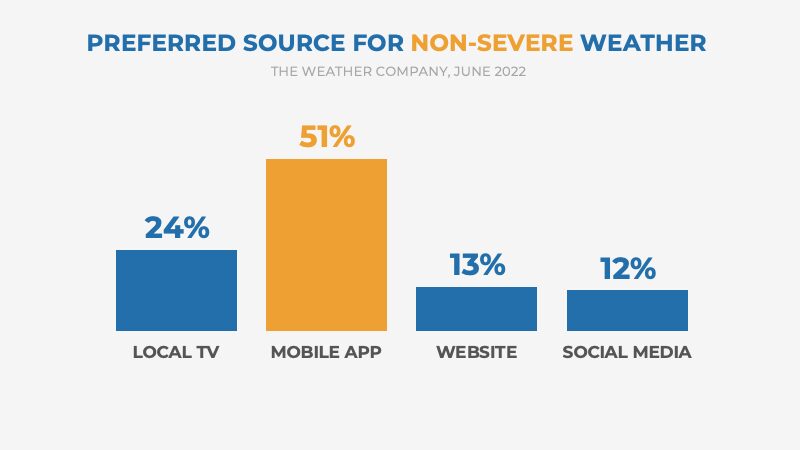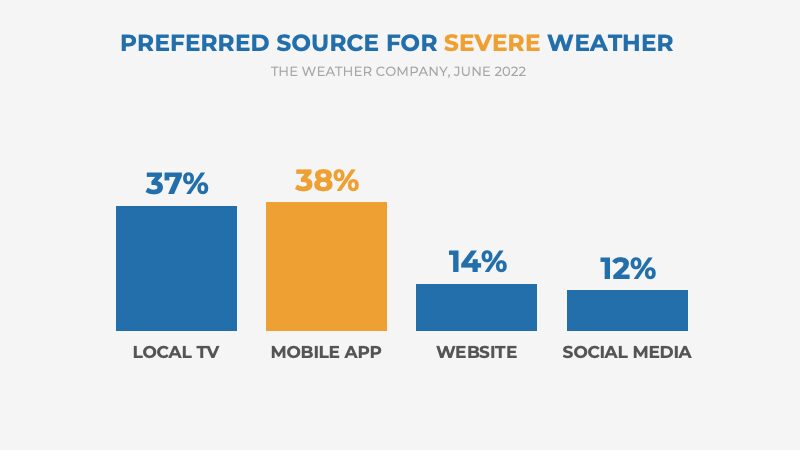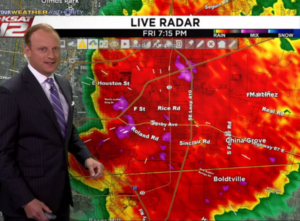New Research: Preferred source for weather is NOT local TV newscasts

There’s good and bad news for broadcast meteorologists in the latest research conducted by Magid for The Weather Company, an IBM Business.
First, the bad news.
When there’s no threat of severe storms, consumers say their preferred source of weather information is a mobile app. People prefer mobile apps two-to-one over local TV newscasts.

In times of severe weather, local television news is virtually tied with the mobile app among all users. However, consumers aged 18-44 prefer getting weather updates on a mobile app by a two-to-one margin. Older viewers still favor local TV during severe weather, but even they think mobile apps are better when there’s no severe weather.

I previously wrote, “We are slowly being replaced by a piece of technology that fits in the palm of your hand.” That sentence didn’t age well. This research suggests we’ve already lost the weather war with mobile apps.
What’s the good news? Most television stations have a mobile app. And the biggest difference between your station-branded app and other apps is…you!
Deliver the message on-air and online
Viewers surveyed said local TV weathercasts have become repetitive and focus on information viewers already know. Many think the maps and graphics are confusing. Some find broadcast meteorologists too scientific, boring, and unable to explain simple changes in the weather.
This is an easy fix. Broadcast meteorologists must stop being repetitive and start focusing on the fundamentals of effective weather communication. We must clean up the weather visualizations so people can easily understand them. We need to identify appropriate opportunities within the weathercasts to share our personality and demonstrate our expertise. And we need to do this every hit, every day.
READ MORE: ARE BROADCAST METEOROLOGISTS OPERATING OUT OF FEAR OR COURAGE?
 When it comes to the webcast on the mobile app and website, many television stations upload a copy of the last on-air weathercast. That’s not digital-first. That’s digital-earlier-today, and in some cases, it’s digital-yesterday. We can do better than that.
When it comes to the webcast on the mobile app and website, many television stations upload a copy of the last on-air weathercast. That’s not digital-first. That’s digital-earlier-today, and in some cases, it’s digital-yesterday. We can do better than that.
Establishing a digital-now format keeps the online weather content relevant and fresh. Whenever someone clicks play on the weather webcast, consumers should find information that helps them plan their day, not a recap of what the weather was several hours ago.
Digital platforms give broadcast meteorologists an opportunity to create content that complements and supplements the on-air weather coverage. While the daily webcast provides an overview of the next 24-48 hours, a second video could do a deep dive into the meteorologist’s thoughts about the next big storm. Additional videos might offer historical context, climatological details, or a forecast for special events.
Some television stations broadcast live on their mobile app. My coaching clients at KSAT in San Antonio regularly produce Appcasts to cover severe and disruptive weather events. According to Adam Caskey, the weekday evening meteorologist, almost a quarter million people tune in for some of the live weather updates on the station’s mobile app. Not too shabby for a city with a population of 1.5 million.
New definition, new priorities
The term broadcast meteorologist historically referred to television and radio weather forecasters. Today we cast our weather information over a broad number of media outlets: television and radio, as well as social media, streaming services, websites, and mobile apps. No matter what platform people use to access our weather information, we must always deliver the essential message.
For many people, the second screen is the primary and preferred source of weather information. Rather than turn on the television and wait for the next weather update, viewers want it now. And they can get it now. But instead of competing against three or four other television stations, we are competing with the rest of the internet and thousands of other mobile apps.
Tim Heller is an AMS Certified Broadcast Meteorologist, Talent Coach, and Weather Content Consultant. He helps local TV stations and broadcast meteorologists implement effective weather coverage strategies on-air, online, and on social media.
